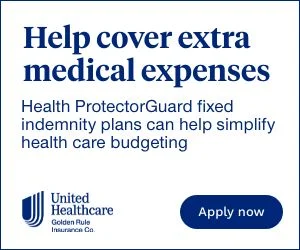With the ever-increasing forms of entertainment you can play on your phone — music, podcasts, and movies included — you also have more devices to help you listen to them.
Take earbuds, those tiny speakers that sit inside your ears. They make it easier to tune out the background noise and focus on whatever you’re enjoying.
But they come with a big downside, especially if you don’t pay attention to the volume: potential hearing loss.
“Many years ago, hearing loss was viewed as an older person’s medical condition,” says Diane Nens, an audiologist and the senior director of clinical engagement and strategic initiatives for UnitedHealthcare Hearing. “Now we’re seeing more and more younger folks joining in those numbers.”
This has everything to do with sound, which is measured in decibels. Sounds at or below 70 decibels (dBA) won’t likely cause hearing loss.
But long or repeated exposure to sounds at or above 85 dBA can cause what’s known as noise-induced hearing loss (NIHL). And if you listen to music through headphones at maximum volume, it runs in the 94-110 dBA range, like concerts and sporting events.
Still, age is the greatest factor in determining hearing loss. In fact, it’s most common and noticeable among older adults. Nearly half of people older than 60 suffer from hearing loss in at least one ear.
But roughly 30 million Americans 12 and older have hearing loss in both ears, and 37.5 million people 18 and over report some trouble hearing. That’s according to the National Institute on Deafness and Other Communication Disorders.
Hearing loss is also becoming more widespread, in part, due to an aging population and because of the number of people using earbuds to listen to loud music or podcasts, says Nens.
Per the World Health Organization, more than 1 billion young adults are at risk of permanent, avoidable hearing loss due to unsafe listening practices.
If you’re experiencing hearing loss — or even just worried about it — these 3 steps can help:
If you’re not Medicare eligible just yet, there are other options too. UnitedHealthcare branded dental plans from Golden Rule Insurance Company include access to discounts on hearing exams and hearing aids. Learn more about those plans here.
1. Turn it down
Nens says that turning down the volume on whatever you’re listening to is the easiest way to mitigate noise-induced hearing loss. She notes that this is particularly helpful for people who listen to music through earbuds at high volumes.
Nens suggests that people follow what’s called the 60/60 rule: Spend no more than 60 minutes at a time, listening to audio content at no more than 60% of your device’s maximum volume.
She adds that the prolonged use of earbuds or headphones, especially at high volume, may contribute to noise-induced hearing loss.
“We’re not saying don’t use earbuds or headphones,” says Nens. “We’re saying use them safely.”
2. Ask your provider for a hearing evaluation
New advances are making it more convenient to access hearing testing. If you suspect you may have hearing loss, you can start by taking an initial online screening to determine if you have hearing loss.
From there, you can meet with an audiologist who will conduct a complete hearing test, make a formal diagnosis and review your options.
One option may be to get hearing aids, which are tiny devices that sit on or in a patient’s ear and help to amplify sounds. They work for many people who’ve already experienced hearing loss.
Coverage for hearing aids does vary — and they could cost quite a bit. For instance, Original Medicare and many other insurance plans don’t cover hearing aids, and 61% of patients end up paying the full bill, which can average $1,675 per ear.
But many Medicare Advantage plans do cover hearing aids. And you can find savings.
If you’re not Medicare eligible just yet, there are other options too. UnitedHealthcare branded dental plans from Golden Rule Insurance Company include access to discounts on hearing exams and hearing aids. Learn more about those plans here.
Ready to explore insurance plans where you live?
3. Explore your hearing aid options
If you and your provider decide hearing aids are the way to go, you’ll have a variety of shapes, sizes, and features to choose from. Some can even be adjusted remotely, without patients ever having to see a hearing professional.
The most popular hearing aids are the receiver in the canal (RIC), with the speaker inside an insertable dome that fits inside the ear, and the behind the ear (BTE) with slim tube model, which sits behind the ear. They’re lightweight, comfortable, and less visible.
Nens notes that you should always consider your hearing aids’ battery life. With many newer devices, you can take off your hearing aids at night and put them in a case, where they charge while you’re asleep. These hearing aid batteries can go up to 18 hours without having to be recharged, depending on use and other technical factors.
In contrast, traditional hearing aid batteries last an average of 5 to 7 days, depending on their size.
According to Nens, hearing aids not only help a patient hear better, but they also have a huge impact on the patient’s quality of life.
Many older adults who suffer from hearing loss, for example, tend to isolate themselves from friends and family out of shame or embarrassment. Hearing loss can also triple the risk of accidental falls.
Nens says that when she treats patients for hearing loss, she tries to provide them with every kind of resource to improve their hearing and overall well-being.
“The goal is to improve access and quality of life,” she says. “Nobody should have to live with untreated hearing loss.”
If you’re not Medicare eligible just yet, there are other options too. UnitedHealthcare branded dental plans from Golden Rule Insurance Company include access to discounts on hearing exams and hearing aids. Learn more about those plans here.
This article contains information that is not compiled by UnitedHealthcare or any of its subsidiaries. UnitedHealthcare does not represent all the information provided are statements of fact. Please consult directly with your primary care physician if you need medical advice.
UHOHEARLOSSA1
Source List:
AARP. "8 Ways to Save Money on Hearing Aids." December 16, 2021. Retrieved from https://www.aarp.org/health/conditions-treatments/info-2021/saving-on-hearing-aids.html.
Archives of Internal Medicine. "Hearing Loss and Falls Among Older Adults in the United States." Retrieved from https://www.ncbi.nlm.nih.gov/pmc/articles/PMC3518403/?report=reader#!po=10.0000. Accessed January 3, 2022.
Centers for Disease Control and Prevention. "Loneliness and Social Isolation Linked to Serious Health Conditions." April 29, 2021. Retrieved from https://www.cdc.gov/aging/publications/features/lonely-older-adults.html.
Johns Hopkins Medicine. "One in Five Americans Has Hearing Loss." Retrieved from https://www.hopkinsmedicine.org/news/media/releases/one_in_five_americans_has_hearing_loss. Accessed January 3, 2022.
Johns Hopkins Medicine. "Otolaryngology-Head and Neck Surgery." Retrieved from https://www.hopkinsmedicine.org/otolaryngology/specialty_areas/hearing/hearing-aids/ Accessed January 3, 2022.
Mayo Clinic. "Hearing aids: How to choose the right one." October 21, 2020. Retrieved from https://www.mayoclinic.org/diseases-conditions/hearing-loss/in-depth/hearing-aids/art-20044116.
Mayo Clinic. "Hearing loss." April 16, 2021. Retrieved from https://www.mayoclinic.org/diseases-conditions/hearing-loss/symptoms-causes/syc-20373072.
Mayo Clinic. "Hearing loss." April 16, 2021. Retrieved from https://www.mayoclinic.org/diseases-conditions/hearing-loss/diagnosis-treatment/drc-20373077.
Mayo Clinic. "Mayo Clinic Minute: The 60-60 rule for safer listening." September 8, 2017 Retrieved from https://newsnetwork.mayoclinic.org/discussion/mayo-clinic-minute-the-60-60-rule-for-safer-listening/#.
Medicare.gov. "Hearing aids." Retrieved from https://www.medicare.gov/coverage/hearing-aids. Accessed January 3, 2022.
Miracle Ear. "How to Make Hearing Aid Batteries Last Longer." April 17, 2019. Retrieved from https://www.miracle-ear.com/blog-news/how-to-make-hearing-aid-batteries-last-longer.
Miracle Ear. "Rechargeable Hearing Aids." Retrieved from https://www.miracle-ear.com/hearing-aids/features-benefits/rechargeable. Accessed January 3, 2022.
National Institute on Deafness and Other Communication Disorders. "Noise-Induced Hearing Loss." May 31, 2019. Retrieved from https://www.nidcd.nih.gov/health/noise-induced-hearing-loss.
National Institute on Deafness and Other Communication Disorders. "Quick Statistics About Hearing." March 25, 2021. Retrieved from https://www.nidcd.nih.gov/health/statistics/quick-statistics-hearing
President’s Council of Advisors on Science and Technology. "Aging America & Hearing Loss: Imperative of Improved Hearing Technologies." October 2015. Retrieved from https://obamawhitehouse.archives.gov/sites/default/files/microsites/ostp/PCAST/PCAST%20hearing%20letter%20report.pdf.
The Oregon Clinic. "Slim Tube Behind the Ear Hearing Aids." Retrieved from https://www.oregonclinic.com/specialties/ear-nose-throat/audiology/slim-tube-behind-the-ear-hearing-aids. Accessed January 3, 2022.
UnitedHealthcare Hearing. "Take an online hearing test." Retrieved from https://uhchearing.com/test. Accessed January 3, 2022.
U.S. Department of Veterans Affairs. "Better Hearing for Veterans, remotely." June 24, 2020. Retrieved from https://blogs.va.gov/VAntage/76188/better-hearing-veterans-remotely/.
World Health Organization. "Deafness and hearing loss." April 1, 2021. Retrieved from https://www.who.int/news-room/fact-sheets/detail/deafness-and-hearing-loss.











